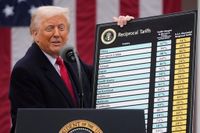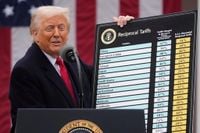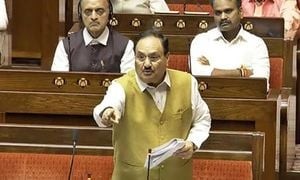US President Donald Trump has announced a sweeping tariff package that significantly impacts the European Union, marking a pivotal moment in international trade relations. In a press conference held in the White House Rose Garden, Trump declared that the US government will impose new flat tariffs of ten percent on most imports from all countries, with specific higher tariffs targeting imports from the EU set at twenty percent. This move is seen as the most aggressive step in Trump's trade policy to date, potentially leading to a trade war with the EU.
Trump characterized the announcement as a "day of liberation," framing the tariffs as a necessary measure to protect American industry from what he described as unfair practices by foreign nations. "They are gaming us. It’s so sad to see. It’s so pathetic," Trump expressed, highlighting his frustration with European trade practices.
According to the new tariff structure, a universal ten percent tariff will apply to imports from all countries, while additional penalty taxes will vary based on each country’s trade deficit with the US. This complex system aims to address perceived imbalances in trade, particularly targeting nations with high trade barriers against American products.
Trump emphasized the historical significance of the day, stating, "This day will go down in history as the day American industry was reborn, the day America reclaimed its destiny, and the day we began to make America rich again." He lamented that for decades, the US has been exploited by both friendly and rival nations, but insisted that those days are over.
Since returning to the White House, Trump has consistently relied on tariffs as a key component of his economic strategy. He has previously imposed tariffs on all aluminum and steel imports, introduced a twenty-five percent tariff on imported cars and car parts, and increased tariffs on goods from China. These measures have already strained relations with key trading partners, particularly the EU, which could face severe repercussions from the newly announced tariffs.
Experts warn that the new tariffs will have direct consequences for consumers. Import tariffs function similarly to taxes, which means that companies importing goods will bear the cost. It is likely that these companies will pass on the increased costs to consumers, leading to higher prices and potentially reigniting inflation. Trump’s objective is to deter US companies from sourcing products abroad, thereby promoting domestic manufacturing.
However, as retaliatory tariffs are anticipated, exporting companies may face revenue losses, potentially resulting in reduced production and job cuts, which could adversely affect the economy overall. The escalating trade conflict with the EU is expected to have noticeable effects on German consumers, among others. The German chemical industry has already urged for a "cool head" in the face of rising tensions, warning that an escalation could lead to greater damage.
Trump's ongoing criticisms of the EU reflect a broader frustration with the trade imbalance that sees European companies selling significantly more goods in the US than American companies sell in Europe. The new tariffs could be the tipping point that provokes strong countermeasures from Brussels, exacerbating an already tense situation.
The setting for Trump’s announcement was particularly symbolic; it was the first event held in the Rose Garden since his return to the presidency. Trump has previously referred to tariffs as his favorite tool for correcting trade imbalances and bringing jobs back to the US. He aims to assert strength through these measures, accusing other countries of exploiting the US.
Moreover, the revenue generated from these tariffs could help fund Trump’s costly promise of comprehensive tax cuts, serving dual purposes in his economic strategy. Tariffs are also utilized as leverage in negotiations with other countries to achieve favorable outcomes.
As the global economy braces for the repercussions of these new tariffs, both American consumers and international partners are left to navigate the uncertain waters of a potential trade war. The full impact of Trump’s latest trade policies remains to be seen, but one thing is clear: the stakes are high, and the landscape of international trade is shifting dramatically.





